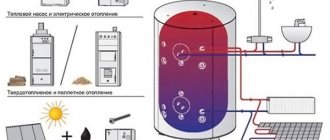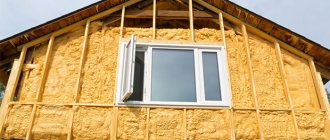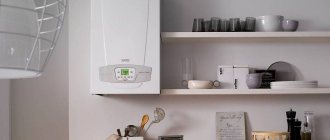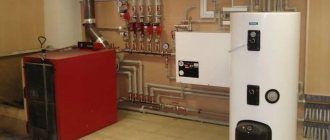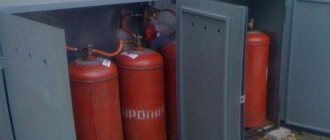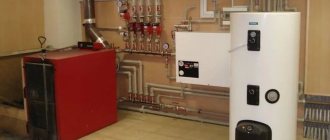home
Heating systems
Calculation
Heating boilers
Choosing a boiler is not difficult, but choosing it correctly for a specific heating system is not easy. Even understanding what dimensions the unit body or its internal volume should be is not a sufficient reason to buy equipment without prior preparation. Modern approaches to circuit design require determining the heat loss indicator, on the basis of which the boiler power for heating a house is calculated. This is explained by the fact that the productivity of the heating unit must compensate for the heat loss of a particular room or building. If you do not start from this principle, then there can be big problems with heat in the house in winter.
Why you can’t do without calculations
- An insufficiently powerful boiler will not be able to heat the coolant to the required temperature, and, therefore, the house will simply be cold. And this is fraught not only with discomfort, but also with the appearance of dampness and mold.
- A boiler with more power than required will have excessive fuel consumption. And it doesn’t matter whether it will be gas, electricity, diesel or wood and coal.
Trying to find the “golden mean” on your own very often becomes an insurmountable obstacle for ordinary homeowners. There is nothing to be surprised or upset about here, since organizing efficient heating requires special engineering knowledge. Contact us and our engineer will calculate the power of the boiler for heating your home - the calculator will be used by our original design.
Systematization of basic and auxiliary input data (cubic capacity, thermal insulation, materials, number of doors and windows), formalization of calculations - these factors allow us to carry out calculations automatically. At the same time, at this stage, calculating a gas boiler for heating a private house with an understanding of the weather characteristics of a particular area is also of key importance, since each climate zone has its own parameters. The obtained indicators of estimated heat loss will greatly facilitate not only the choice of a boiler, but also other devices included in the heating system circuit.
How to calculate the power of a heating boiler
Calculations are usually entrusted to qualified specialists. This is justified by many nuances that need to be taken into account. But not every home owner resorts to a paid service, so everything is done independently.
What you need to consider for calculations
The heating system must provide a comfortable temperature in the house on a constant basis. The norm is considered to be +20-+22℃ in accordance with current regulations. To determine the required boiler power for this, consider the following:
- information on the serviced area;
- readings of low temperatures outside in winter (the coldest week);
- total calculation of heat loss.
The first two points are easy to determine on your own. Here you need the height of the ceilings, the length and width of the walls, the number of windows and external structures. Thermometer readings can be found in the tables. Heat leaks occur through all structures of the house. Therefore, for the overall result, it will be more effective to carry out calculations for each room separately and summarize the results. There are many factors to consider here, which will be discussed below.
The device of an electric boiler with a heating element
The simplest electric heating system consists of a heat exchanger with a coolant (water or antifreeze), inside of which heating elements (tubular electric heaters - heating elements) are placed.
Electric boiler design diagram.
Here's the simplest design. And the design of the heating element itself is even simpler (see image 1). A high electrical resistance coil is placed in a thin-walled metal tube and insulated from it by filling the entire space with insulating material (magnesium oxide). The ends of the spiral are attached to the leads, which are pressed into porcelain insulators. This entire structure is sealed against the coolant, and the insulators are hermetically placed outside the heating tank.
Low-power boilers operate from a single-phase 220 V network. Boilers with a power exceeding 12 kW use a three-phase 380 V electrical network and, therefore, three heating elements. When powered from a voltage of 220 V, it is necessary to have a three-wire cable (phase, zero and protective grounding); when powered from a three-phase network, it is necessary to have a five-wire cable (three phases, working zero and grounding). This is a simple diagram of boilers using natural circulation of coolant. For forced circulation, a low-noise circulation pump is provided.
Gas boiler power calculation
Single-circuit boilers are used only for space heating; with two circuits, units are additionally connected to hot water supply. There is no universal algorithm for determining the required power, since all systems are assembled according to an individual project.
For typical heating schemes with ceiling heights up to 3 m, the volume of serviced space and microclimate are not taken into account. Here the result is obtained by multiplying 1 kW/10 sq.m (specific thermal power) by the total area of the house and a correction factor for a specific region (the value is taken from the tables). For example, near Moscow for 100 sq.m. 15 kW will be required.
In dual-circuit devices, water flows cyclically, heating and cooling. Here add 20% to the results already obtained. That is, using the example in the Moscow region, the result will be 18 kW.
To clarify the required parameter, it is necessary to take into account the heat dissipation coefficient. Information is also available in official tables. So, if all structures in a house consist of modern materials with thermal insulation, then the value can be in the range of 0.6-0.9, and for single brickwork from 2 to 2.9. That is, the power of the equipment for hot water supply will have to correspond to more than 10.8 or 36 kW.
The online calculator is programmed to take into account most of the nuances and provide results in a matter of minutes. It is enough to enter the following data: area, type of windows, degree of thermal insulation and number of external walls, negative thermometer readings, ceiling height.
Electrical energy consumption. How to define it?
We will need some calculations to achieve the desired result.
In addition, the calculation requires taking into account a number of parameters:
- Average daily duration of work at maximum load;
- Residence mode;
- Efficiency and productivity;
- Calculation of operating hours during the heating season;
- The volume of coolant in the heating circuit;
- Tank size of the heating device;
- Calculation of heating area;
- Heating device voltage;
- Calculation of power cable cross-section;
- Calculation of the volume of heated premises;
- Number of circuits in the equipment.
The calculation assumes the use of average values. Several adjustments are required for factors such as the type of thermal insulation used, the thermal conductivity of the walls, temperature readings, and so on. Power should also take this into account.
An electric heating boiler requires the use of a special cable. The main factor when choosing it is power. There is a simple empirical relationship here, which is not difficult to understand: the cross-sectional area of the cable in mm2 for a single-phase electric boiler must be no less than the heating power, expressed in kW. This makes the calculation simpler. It is necessary to coordinate your actions with the authorities that monitor the use of resources if the indicator for the boiler is at the level of 10 kW or more.
Rice. 2 Device from the inside
Calculation of solid fuel boiler power
An approximate result here can be obtained by multiplying the average power by 10 kW. m. The value is equivalent to 1.2 kW, subject to a ceiling height of up to 3 m, a good situation regarding the insulation of the house. For example, near Kiev, 35 kW is enough for a total area of up to 300 m. The recommended margin with this method of calculation is 30%. That is, the result is equal to 45.5 kW.
Equipment differs according to the type of heat source used. This takes into account the rate of fuel combustion, which affects the additional power reserve. For example, the result for a pyrolysis boiler for the same area will be in the range of 75-85 kW.
In addition, underfloor heating systems, additional radiators, thermal conductivity and pipe cross-section must be taken into account. The online calculator program contains most of the key parameters and constant data from official tables.
Advantages and disadvantages of electric heating
The advantages include:
Diagram of operation of an electric boiler.
- environmental safety (no harmful fuel combustion waste);
- quiet operation;
- simple schemes for organizing automatic operation;
- there is no need for chimneys (when using a condensing gas boiler, a drain will also be required to remove condensate);
- ease of operation;
- Compared to a gas boiler, you will have to issue a significantly smaller number of permitting documents. In most cases, permission from Energonadzor is sufficient.
The silent operation of heating boilers and environmental friendliness allow them to be located directly in the room, which is facilitated by the absence of chimneys. Consequently, installation of an electric heating boiler, both floor and wall-mounted, is not difficult.
The disadvantages of this heating option include significantly higher heating costs compared to gas counterparts. The advantage of the condensing gas analogue is especially great. Therefore, electric heating is forced to be used in places where there is no centralized gas supply.
Online home heat loss calculator
Heat leakage occurs through all sorts of cracks, during ventilation, through the materials that make up each house structure (here we mean heat transfer resistance). Also, in order to calculate heat loss, you need to know the difference in the readings of a home and outdoor thermometer, the situation with winds and solar radiation, the location of the building relative to the cardinal points and various bodies of water.
Mikhail Egorov
Heating system specialist with 15 years of experience
Ask a Question
Before deciding to purchase boiler equipment and determining its power, take measures to reduce heat loss. This way you won’t have to use gas or solid fuel for compensatory heating of your home.
Making calculations on your own will not be easy and will take a lot of time. Here you will need to search for tables with constant values and determine the composition of all house structures, including the thickness of each layer. This does not take into account various types of malfunctions. For programmatic calculation, enter the name of the city for minus and the desired temperature. Next, fill out the following sections:
- Walls. There is a ventilated gap on the facade, its total area. The composition and thickness of each layer of supporting structures are also taken into account.
- Window. Type of glazing, number and sizes of openings.
- Ceiling. Information about what is located above the ceiling, area, composition and thickness of materials.
- Floor. Similar data.
- Infiltration. Here you only need the total area of living space.
The calculator produces approximate indicative results, so it is still recommended to check them experimentally. It is impossible to enter data on the full state of structures into the program. For example, for various reasons, condensation may form inside the walls, and the floor or ceiling may periodically become damp. And moisture significantly increases the thermal conductivity of materials.
Some tips for choosing
Each manufacturer is now trying to provide the buyer with a full set of equipment that he may need, power is also taken into account. The electric boiler was no exception. It comes complete with a programmer, a pump for coolant circulation, and an expansion tank. Thanks to this, it is easy to understand what the power indicator of an electric boiler should be. Even a novice user can handle this.
In addition, devices to protect equipment and special cables are required. Thus, the installation can be completely done by yourself. The power of the boiler does not matter.
But sometimes independent additional equipment is required. For those who understand electric models, this solution is often the most relevant. Including power. The power supply system can be used of the usual type if an electric boiler is installed, the power of which reaches 6 kW.
Recently, the electricity consumption of an electric boiler has become no less important an indicator than the installation of a special pump in the system. This solution also helps to understand how much electricity is being wasted and why. In this case, consumption is noticeably reduced. The system will be able to use pipes with a smaller diameter than in a normal situation. A wet rotor pump is the main type of equipment that can most often be seen in private homes. Its power fully meets the requirements.
- The rotor is washed with liquid, which is never pumped by electrical equipment. Resource consumption becomes more profitable.
- No additional fan is required because the device never overheats. The boiler's power is sufficient for normal loads.
- Due to the fact that there is no fan, the operation of the entire system becomes almost silent. In residential premises this becomes especially relevant; power does not suffer from this.
Such pumps themselves can support automatic or manual adjustment. Power in this case does not play a big role. The first option is the most preferable because it saves energy. Then heating with an electric boiler itself becomes more profitable.
How much does his work cost? To make a calculation, it is enough to know about some operating features. For example, what temperature is most often maintained in the room. As for the general scheme for heating a house, it is better to choose forced circulation. This is also the best option, allowing you to achieve maximum results with minimal investment.
Ratio “1 kW per 10 sq. m"
This calculation method is good for its simplicity, but the results it gives are very approximate. Thus, as a rule, only a preliminary assessment of the required power of the installed boiler equipment is carried out.
Sometimes a slightly different formula is used. The area of the room (in square meters) is divided by ten, and then another fifth is added to the result. The resulting number is the power of the suitable boiler in kilowatts. This method is also not particularly accurate, but may be useful during preliminary calculations.
What is the power of an electric boiler
An electric boiler is a reservoir with a heat exchanger through which tap water or a special coolant with increased thermal characteristics is pumped.
The boiler is connected to a household AC network; it heats the water using heating elements or electrodes isolated from the water. The design of the equipment includes a temperature regulator.
Power consumption depends on the degree of cooling of the coolant during circulation through the heating radiators in the building. Part of the energy is spent on heat losses in the boiler design (heating the walls or protective casings of the heating elements). An information plate is installed on the external part of the equipment, which indicates the operating parameters of the product and power consumption.

